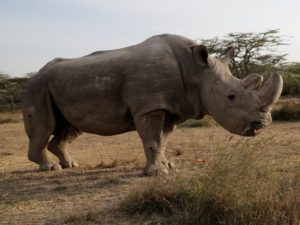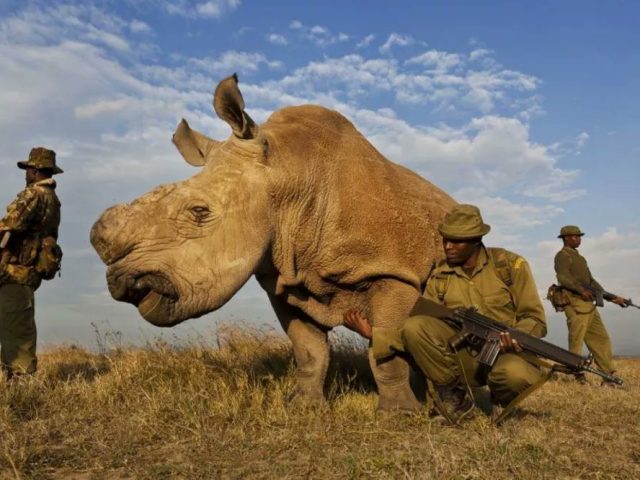|
Getting your Trinity Audio player ready...
|
By Ol Pejeta
It is with great sadness that Ol Pejeta Conservancy and the Dvůr Králové Zoo announce that Sudan, the world’s last male northern white rhino, age 45, died at Ol Pejeta Conservancy in Kenya on March 19th, 2018. Sudan was born in 1973 and has been undergoing treatment for age-related complications that led to degenerative changes in muscles and bones combined with extensive skin wounds. His condition worsened significantly in the last 24 hours; he was unable to stand up and was suffering a great deal. The veterinary team from the Dvůr Králové Zoo, Ol Pejeta, and Kenya Wildlife Service (KWS) made the decision to euthanize him.
Sudan will be remembered for his unusually memorable life. In the 1970s, he escaped extinction of his kind in the wild when he was moved to Dvůr Králové Zoo. Throughout his existence, he significantly contributed to the survival of his species as he sired two females. Additionally, his genetic material was collected yesterday and provides a hope for future attempts at the reproduction of northern white rhinos through advanced cellular technologies. During his final years, Sudan came back to Africa and stole the heart of many with his dignity and strength.
“We on Ol Pejeta are all saddened by Sudan’s death. He was a great ambassador for his species and will be remembered for the work he did to raise awareness globally of the plight facing not only rhinos but also the many thousands of other species facing extinction as a result of an unsustainable human activity. One day, his demise will hopefully be seen as a seminal moment for conservationists worldwide,” said Richard Vigne, Ol Pejeta’s CEO.
Unfortunately, Sudan’s death leaves just two female northern white rhinos on the planet; his daughter Najin and her daughter Fatu, who remain at Ol Pejeta. The only hope for the preservation of this subspecies now lies in developing in vitro fertilization (IVF) techniques using eggs from the two remaining females, stored northern white rhino semen from males and surrogate southern white rhino females.
How did we get to this point?
The poaching crisis of the 1970s and 80s, fueled by demand for rhino horn in Traditional Chinese Medicine in Asia and dagger handles in Yemen, wiped out the northern white rhino populations in Uganda, Central African Republic, Sudan and Chad. The last remaining wild population made up of 20-30 rhinos in Garamba National Park in the Democratic Republic of the Congo succumbed to fighting in the region during the 1990s and early 2000s. By 2008, the northern white rhino was considered by most experts to be extinct in the wild.

In 2009, the last four fertile northern white rhinos – two males and two females – were moved to Ol Pejeta from Dvůr Králové Zoo in the Czech Republic, with support from Fauna & Flora International and the Kenya Wildlife Service. It was hoped that the climate and rich grasslands of the Conservancy, similar to the native habitat of this subspecies, would provide them with more favorable breeding conditions.
On arrival at Ol Pejeta, the four were placed under 24 hours armed surveillance and fed a supplemented diet. However, despite the fact that they were seen mating, there were no successful pregnancies.
In early 2014, plans to introduce a male southern white rhino to the two female northern whites got underway in the hopes that if breeding were successful, the hybrid offspring would at least conserve some of the northern white genes. Again, this proved unsuccessful. Tests later revealed that neither of the females was capable of natural reproduction and that only one was fertile enough to conceive artificially. The death of the other northern white male, Suni, of natural causes in October 2014, further emphasized the need to urgently come up with alternative solutions.
What next?
With options running out, scientists are attempting to develop “artificial reproductive techniques” (or ARTs), including IVF to rescue this subspecies. To that end, Ol Pejeta Conservancy and Dvůr Králové Zoo are now partnering with IZW Berlin, Avantea Cremona and the Kenya Wildlife Service to try and conduct the first-ever procedure to safely remove egg cells from remaining females, fertilize these with semen previously collected from northern white males, and insert the resulting embryos into female southern white rhinos acting as surrogates. This has never been done before in rhinos and does not come without risks.
“Sudan was the last northern white rhino that was born in the wild. His death is a cruel symbol of human disregard for nature and it saddened everyone who knew him. But we should not give up. We must take advantage of the unique situation in which cellular technologies are utilized for conservation of critically endangered species. It may sound unbelievable, but thanks to the newly developed techniques even Sudan could still have an offspring,” said Jan Stejskal, Director of International Projects at Dvůr Králové Zoo. “We will be happy for everyone who will help us in our joint effort.”
The estimated cost of IVF – from the development of the method to trials, implantation and the creation of a viable breeding herd of northern whites – could be as much as US$ 9 million. Yet this is the hope for preserving an entire subspecies. Ol Pejeta and Dvůr Králové Zoo are asking supporters to donate towards this campaign in memory of Sudan, to help us raise the funds needed before it’s too lateVisit. For supporters, based in the UK, please donate on this portal.














